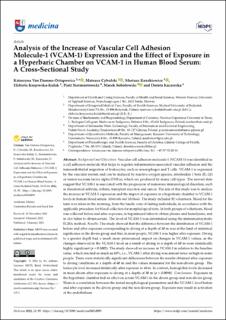| dc.contributor.author | van Damme-Ostapowicz, Katarzyna | |
| dc.contributor.author | Cybulski, Mateusz | |
| dc.contributor.author | Kozakiewicz, Mariusz | |
| dc.contributor.author | Krajewska-Kulak, Elzbieta | |
| dc.contributor.author | Siermontowski, Piotr | |
| dc.contributor.author | Sobolewski, Marek | |
| dc.contributor.author | Kaczerska, Dorota | |
| dc.date.accessioned | 2022-10-03T10:49:54Z | |
| dc.date.available | 2022-10-03T10:49:54Z | |
| dc.date.created | 2022-01-08T12:53:55Z | |
| dc.date.issued | 2022 | |
| dc.identifier.citation | Van Damme-Ostapowicz, K., Cybulski, M., Kozakiewicz, M., Krajewska-Kułak, E., Siermontowski, P., Sobolewski, M., & Kaczerska, D. (2022). Analysis of the Increase of Vascular Cell Adhesion Molecule-1 (VCAM-1) Expression and the Effect of Exposure in a Hyperbaric Chamber on VCAM-1 in Human Blood Serum: A Cross-Sectional Study. Medicina, 58(1):95. | en_US |
| dc.identifier.issn | 1010-660X | |
| dc.identifier.uri | https://hdl.handle.net/11250/3023311 | |
| dc.description.abstract | Background and Objectives: Vascular cell adhesion molecule-1 (VCAM-1) was identified as a cell adhesion molecule that helps to regulate inflammation-associated vascular adhesion and the transendothelial migration of leukocytes, such as macrophages and T cells. VCAM-1 is expressed by the vascular system and can be induced by reactive oxygen species, interleukin 1 beta (IL-1β) or tumor necrosis factor alpha (TNFα), which are produced by many cell types. The newest data suggest that VCAM-1 is associated with the progression of numerous immunological disorders, such as rheumatoid arthritis, asthma, transplant rejection and cancer. The aim of this study was to analyze the increase in VCAM-1 expression and the impact of exposure in a hyperbaric chamber to VCAM-1 levels in human blood serum. Materials and Methods: The study included 92 volunteers. Blood for the tests was taken in the morning, from the basilic vein of fasting individuals, in accordance with the applicable procedure for blood collection for morphological tests. In both groups of volunteers, blood was collected before and after exposure, in heparinized tubes to obtain plasma and hemolysate, and in clot tubes to obtain serum. The level of VCAM-1 was determined using the immunoenzymatic ELISA method. Results: The study showed that the difference between the distribution of VCAM-1 before and after exposure corresponding to diving at a depth of 30 m was at the limit of statistical significance in the divers group and that, in most people, VCAM-1 was higher after exposure. Diving to a greater depth had a much more pronounced impact on changes in VCAM-1 values, as the changes observed in the VCAM-1 level as a result of diving to a depth of 60 m were statistically highly significant (p = 0.0002). The study showed an increase in VCAM-1 in relation to the baseline value, which reached as much as 80%, i.e., VCAM-1 after diving was almost twice as high in some people. There were statistically significant differences between the results obtained after exposure to diving conditions at a depth of 60 m and the values measured for the non-divers group. The leukocyte level increased statistically after exposure to 60 m. In contrast, hemoglobin levels decreased in most divers after exposure to diving at a depth of 30 m (p = 0.0098). Conclusions: Exposure in the hyperbaric chamber had an effect on serum VCAM-1 in the divers group and non-divers group. There is a correlation between the tested morphological parameters and the VCAM-1 level before and after exposure in the divers group and the non-divers group. Exposure may result in activation of the endothelium. | en_US |
| dc.language.iso | eng | en_US |
| dc.publisher | MDPI | en_US |
| dc.rights | Navngivelse 4.0 Internasjonal | * |
| dc.rights.uri | http://creativecommons.org/licenses/by/4.0/deed.no | * |
| dc.title | Analysis of the Increase of Vascular Cell Adhesion Molecule-1 (VCAM-1) Expression and the Effect of Exposure in a Hyperbaric Chamber on VCAM-1 in Human Blood Serum: A Cross-Sectional Study | en_US |
| dc.type | Peer reviewed | en_US |
| dc.type | Journal article | en_US |
| dc.description.version | publishedVersion | en_US |
| dc.rights.holder | © 2022 by the authors. | en_US |
| dc.source.volume | 58 | en_US |
| dc.source.journal | Medicina | en_US |
| dc.source.issue | 1 | en_US |
| dc.identifier.doi | 10.3390/medicina58010095 | |
| dc.identifier.cristin | 1976927 | |
| dc.source.articlenumber | 95 | en_US |
| cristin.ispublished | true | |
| cristin.fulltext | original | |
| cristin.qualitycode | 1 | |

